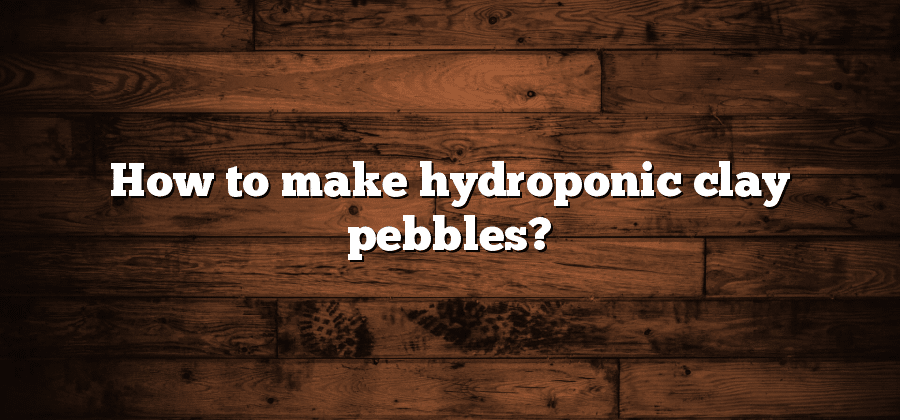Ingredients and Tools Needed
To successfully embark on a hydroponic clay pebble growing system, certain ingredients and tools are imperative. First and foremost, clay pebbles, also known as expanded clay, act as the medium in which plants will grow. These lightweight and porous pebbles provide excellent water retention and aeration, promoting healthy root development. Additionally, a nutrient solution is necessary to provide essential minerals and elements for plant growth. Make sure to choose a high-quality solution formulated specifically for hydroponic systems to ensure optimal results.
Alongside the ingredients, several tools are required for a smooth and efficient hydroponic setup. A pH meter is indispensable to measure and monitor the acidity or alkalinity levels in the nutrient solution. Maintaining the correct pH is crucial for nutrient uptake by the plants. A digital timer is essential to automate the lighting schedule for your hydroponic system. This allows your plants to receive the appropriate amount of light each day, promoting healthy growth. Lastly, a water pump and air stones are necessary to ensure a well-oxygenated and evenly distributed nutrient solution throughout the growing system. These tools, when used in conjunction with the appropriate ingredients, will provide the foundation for a successful hydroponic clay pebble setup.
Clay Pebbles: Understanding the Basics
In the world of hydroponics, clay pebbles have become a popular growing medium among both novice and experienced growers. Also known as expanded clay aggregates or hydroton, these small, round balls provide a number of benefits for plants grown in hydroponic systems. Made from clay that is heated to high temperatures, clay pebbles are inert and do not contain any nutrients themselves. This makes them an ideal choice for hydroponic gardening, as growers have full control over the nutrient solution and can tailor it to the specific needs of their plants.
One of the key advantages of using clay pebbles as a growing medium is their ability to provide excellent drainage and aeration. The porous structure of the pebbles allows excess water to quickly drain away, preventing the roots from becoming waterlogged. At the same time, the air spaces within the pebbles ensure that the roots have access to the oxygen they need for healthy growth. This combination of drainage and aeration helps to prevent the development of root rot and other water-related issues, making clay pebbles especially suitable for hydroponic systems where water is constantly recirculated.
Preparation: Soaking and Cleaning the Clay Pebbles
Soaking and cleaning the clay pebbles is an essential step in preparing them for use in hydroponic systems. Before incorporating the clay pebbles into your system, it is crucial to remove any debris or dust that may be present. This can be done by placing the pebbles in a bucket and filling it with water. Gently agitate the pebbles to dislodge any dirt or impurities, then allow them to soak for about 24 hours.
After soaking, it is time to clean the clay pebbles. This can be done by draining the water and rinsing the pebbles thoroughly. It is recommended to rinse the pebbles several times to ensure that all dirt and residues are removed. Remember to use clean water each time to ensure the pebbles are thoroughly clean.
By soaking and cleaning the clay pebbles, you are ensuring that they are free from any contaminants that may hinder the success of your hydroponic system. This step sets the foundation for a healthy and thriving plant environment where the roots can easily penetrate the pebbles and absorb the necessary nutrients for growth.
Mixing the Clay Pebbles with Nutrient Solution
To achieve optimal growth and productivity in a hydroponic system, it is crucial to properly mix the clay pebbles with the nutrient solution. This step ensures that the plants receive the necessary nutrients in a balanced and efficient manner.
When mixing the clay pebbles with the nutrient solution, it is important to follow a few key guidelines. Firstly, it is recommended to use a clean container that is large enough to hold both the pebbles and the solution. This will allow for proper mixing without any spillage or overflow. Additionally, it is essential to measure the correct amount of nutrient solution based on the specific requirements of the plants being grown. This can vary depending on the plant species, growth stage, and desired outcome. Carefully following the recommended dosage instructions provided by the manufacturer will help ensure proper nutrient concentration.
Creating Optimal pH Levels for Hydroponic Clay Pebbles
To create optimal pH levels for hydroponic clay pebbles, it is essential to understand the importance of maintaining the correct acidity or alkalinity in the nutrient solution. pH levels play a crucial role in nutrient absorption and plant growth. Ideally, the pH range for hydroponic systems using clay pebbles should be between 5.5 and 6.5.
Achieving the desired pH levels requires regular monitoring and adjustment. One effective method for adjusting pH is by using pH up and pH down solutions, which are readily available in most hydroponic stores. It is important to follow the manufacturer’s instructions when using these solutions, as adding too much can lead to drastic shifts in pH levels. Regular testing using pH test strips or a pH meter is also essential in maintaining a stable pH range. By diligently monitoring and adjusting pH levels, growers can provide their plants with the optimal conditions for nutrient uptake, leading to healthy and vigorous growth.






